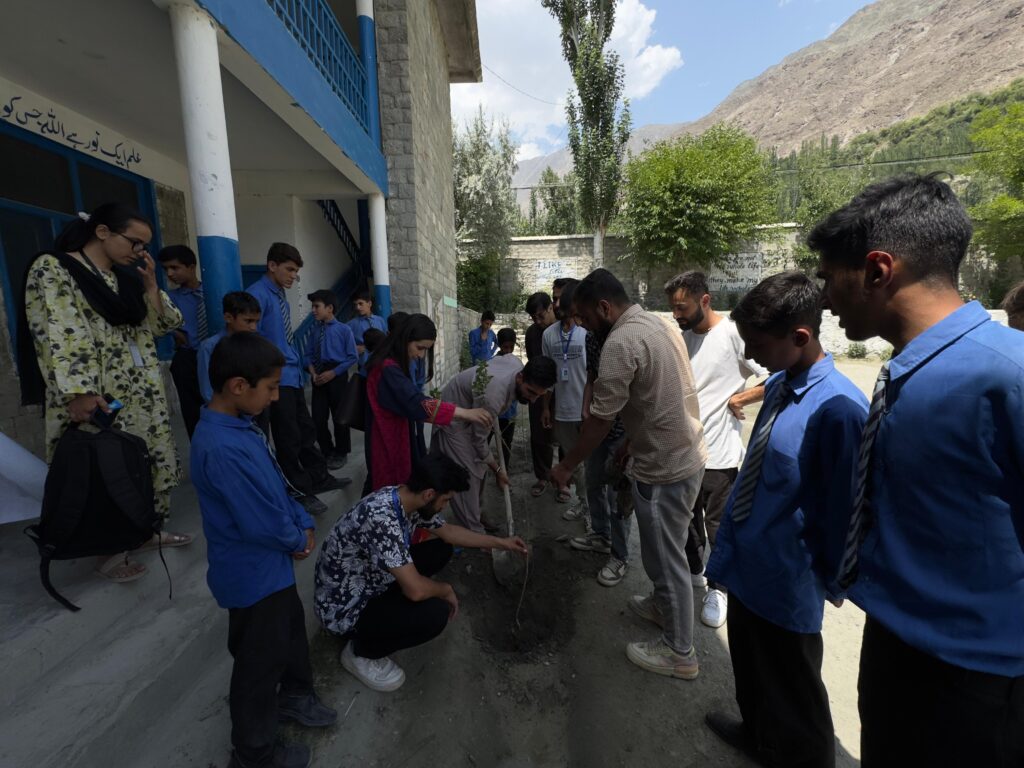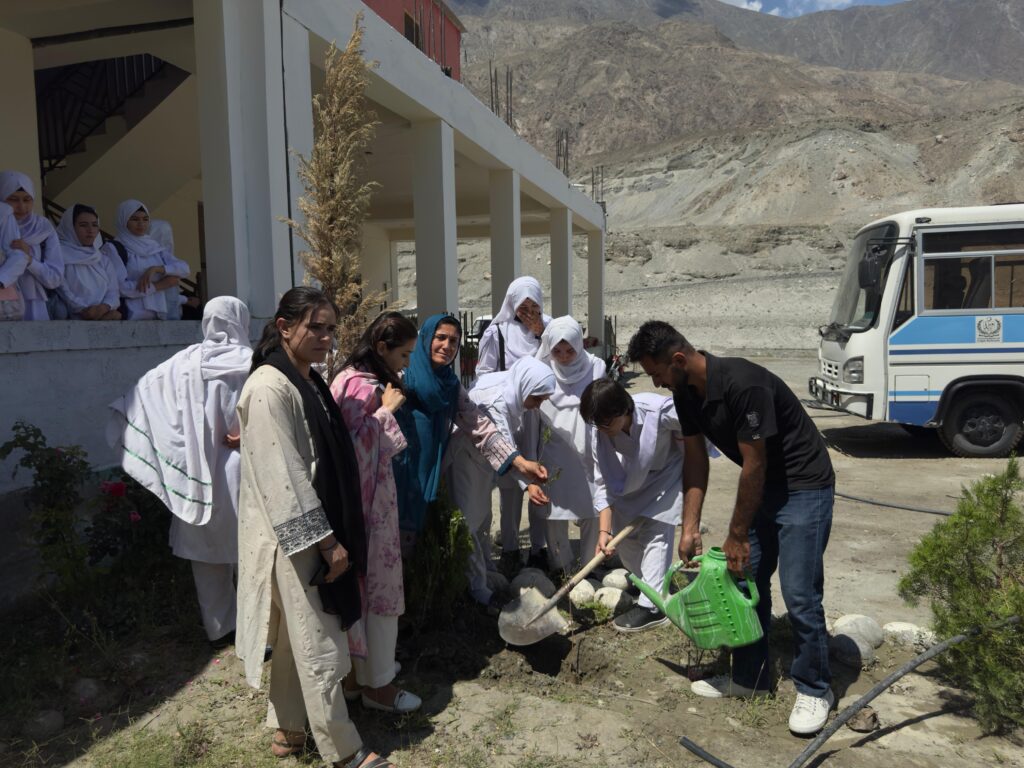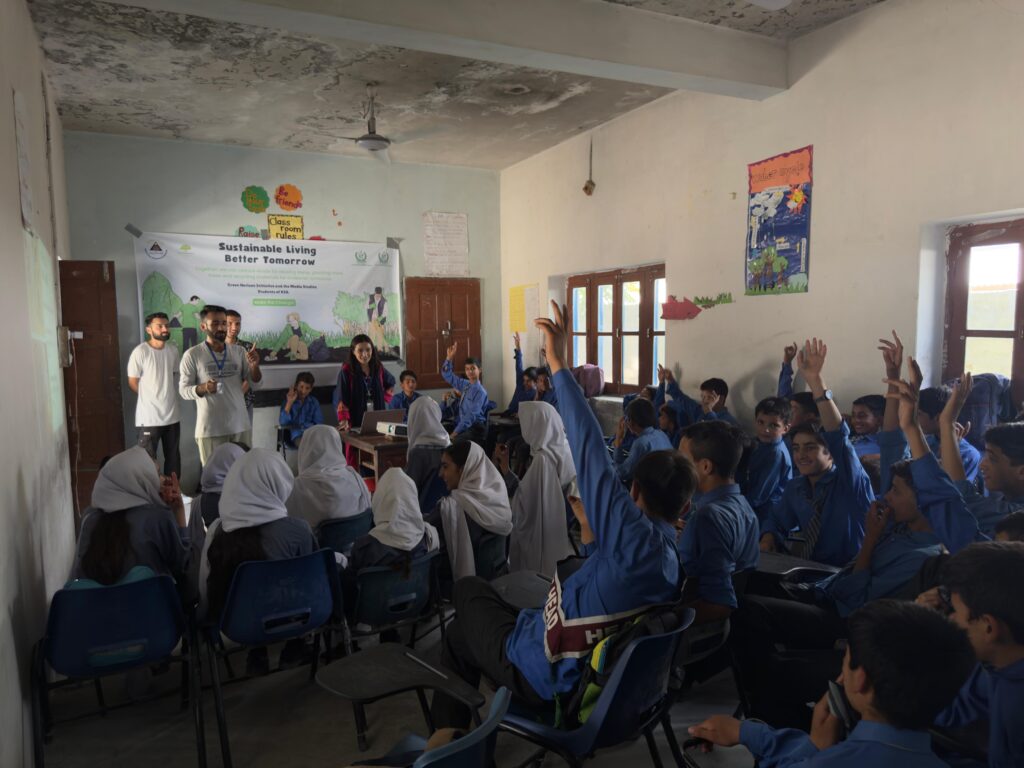By Green Horizon Initiative, Media Science Students at Karakoram International University.
In the heart of the Karakoram Mountains, a quiet but determined movement is taking shape. As students of Media Science at Karakoram International University (KIU), the Green Horizon Initiative, have committed ourselves to protecting our environment, not only through words and awareness campaigns but by taking real, sustainable steps to help our home Gilgit-Baltistan breathe again.
Our mission is simple: “Sustain Tomorrow.” And to achieve that, we’re planting seeds of change literally and figuratively.
The Threat is Real: Warming Mountains and Melting Glaciers.
One of the clearest examples of climate change in GB is the heartbreaking story of the Khurdopin Glacier in Shimshal Valley. In 2017, the glacier surged forward and blocked the Shimshal River, forming a massive glacial lake. By July of that year, this lake burst, flooding large parts of Shimshal and Farmanabad villages within just 60 minutes. The floodwater submerged over 3.21 square kilometers, wiping out homes, agricultural lands, and channel intakes that were vital to local irrigation.
According to data from a study presented at the 6th International Conference on Debris Flows, the glacier lake had grown to a dangerous size of 14.8 hectares, holding nearly 477,000 cubic meters of water. The movement of the glacier over 2.3 km of the Shimshal River was a stark reminder of how fragile our environment has become.
Now, that threat looms again. Khurdopin Glacier is once again showing signs of instability. Communities live in fear, knowing that another Glacial Lake Outburst Flood (GLOF) could strike at any moment.
The Human Cost of Inaction.
What does a glacier bursting mean to the people here? It means destruction of homes, loss of crops, disruption of water channels, and displacement. Agriculture is the backbone of many communities in Gilgit-Baltistan, and the water they depend on comes from these very glaciers. When floods hit, the impact trickles down to every family, every child, every future.
GLOFs are no longer rare occurrences. More than 35 such events have been recorded in Gilgit-Baltistan in the last 200 years. These floods are not just statistics; they are lived realities. Entire villages have been scarred. Shamshal’s example is fresh in memory. Its glacier burst impacted agricultural systems and water channels, and residents are still recovering.
Youth-Led Change: Green Horizon Initiative.
We couldn’t stand by and watch. So we acted.
Under the banner of the Green Horizon Initiative, we have launched awareness campaigns in various schools, colleges, and communities across Gilgit-Baltistan. We are speaking to the next generation because it’s their future at stake.
Our campaigns educate people about climate change, its causes, and its very real local effects. We talk about deforestation, pollution, and the overuse of non-biodegradable materials. But we don’t stop at talking. We believe in doing.
100 Trees, 1 Purpose
We’ve carried out plantation drives at our university, in government schools, and at a degree college. Over 100 trees have been planted. Our goal is not just to plant trees but to cultivate awareness, responsibility, and action. Each tree is a promise a commitment to restoring our ecosystem, reducing carbon footprints, and making Gilgit-Baltistan green again.
Trees are one of nature’s most powerful tools against climate change. They capture carbon dioxide, cool the atmosphere, and stabilize soil. In a mountainous region like ours, they also help prevent landslides and flooding. Planting trees isn’t just symbolic; it’s strategic.



Learning from the Past, Preparing for the Future.
The Khurdopin Glacier study conducted by A. Hussain and his team provides clear evidence: if we don’t change our ways, more disasters will come. The study used advanced tools like HEC-RAS and GIS to model the flood and showed how rapidly these events unfold within just 60 minutes, two major villages were underwater.
This kind of science-based data should be a wake-up call. Our glaciers are our water towers. When they collapse, so does our security, our agriculture, and our way of life.
We believe in solutions. Reforestation, community engagement, responsible consumption, and smarter infrastructure are all within our reach. And youth must be at the center of this movement.
How Can You Help?
Whether you’re a student, a parent, a teacher, or a policymaker, you have a role to play:
- Reforestation: Trees are climate warriors. Local communities must be engaged in tree planting and forest conservation.
- Eco-awareness Education: Climate literacy must be introduced at all school levels. Awareness leads to action.
- Ban Non-Decomposable Plastics: Reduce, reuse, and recycle must become a local mantra.
- Sustainable Infrastructure: Local governments should work on flood-resistant infrastructure in vulnerable areas.
- Community-Based Early Warning Systems: Technology and tradition can work hand in hand to alert villagers before disaster strikes.
Closing Thoughts.
Climate change is not coming. It is already here. The glaciers of Gilgit-Baltistan are melting. The land is cracking. The rivers are raging. But so are we—the youth. With awareness in our minds and green in our hearts, we’re ready to take this fight forward.
The Green Horizon Initiative is just the beginning. Our message is clear: you don’t have to be a scientist or policymaker to make a difference. You just need to care—and act.
Let’s save tomorrow. Starting today.
